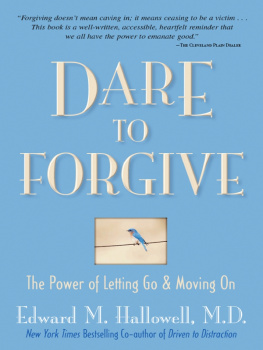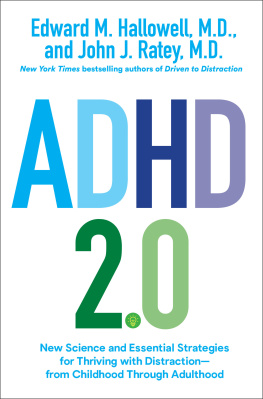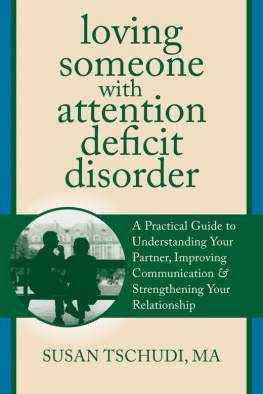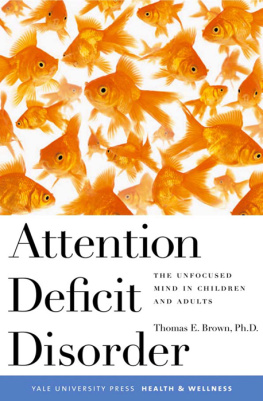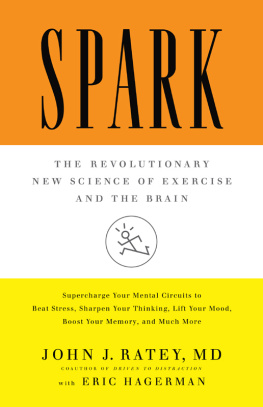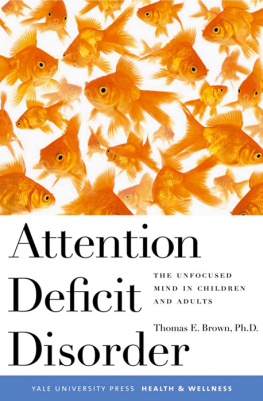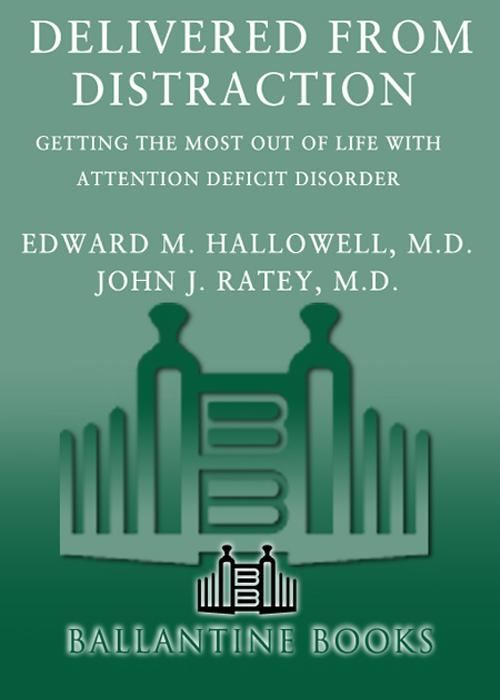
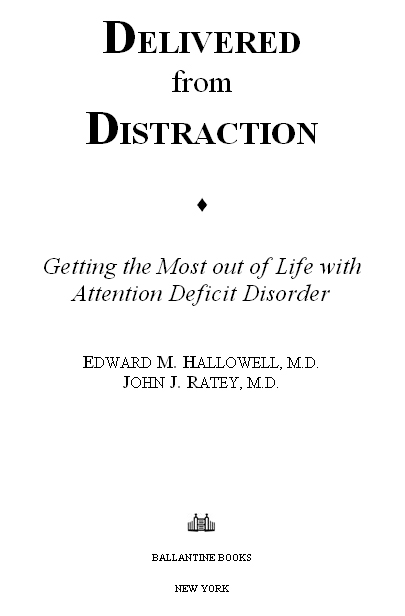
CONTENTS
WHATS IT LIKE TO HAVE ADD?
THREE STORIES THAT TELL THE STORY
MAKING THE DIAGNOSIS OF ADD
MASTERING THE POWER AND AVOIDING THE PITFALLS: THE TREATMENT OF ADD
Since this book is about hope and the power of positive human energies, we dedicate it to the memory of two women who radiated those qualities in their lives:
Josseyln Hallowell Bliss
and
Priscilla Luke Vail
and to one team that never gives up:
The Boston Red Sox
Boy, what ever you is
and where ever you is,
dont be what you aint,
because when you is
what you aint, you isnt.
UNCLE REMUS
ACKNOWLEDGMENTS
Many people helped to create this book.
Above all, John and I would like to thank our patients who contributed their stories, as well as the people who were not patients but contacted us and shared episodes from their lives. Although their names have been changed, all the stories are true; we never could have given this book the power that true stories pack were it not for the courageous cooperation of the dozens of people you find in these pages.
Many other people supported this work. Ginny Grenham, dear friend and creative genius, was most helpful, as always. It was she who urged that a chapter be included on making the transition to college, and she who suggested the chapter on explaining ADD to children. A devoted advocate of all who live with ADD, she always finds the best in people and helps them reach and grasp higher than they think they can.
We also thank Kay Murray and Roxie Nickerson for their painstaking work on the final section of the book, the resource section.
A great number of top experts helped us in our research. We especially want to thank Janet Wozniak for her help on the chapter on bipolar disorder and Demitri Papolos for his comments on that topic. Mel Levine was, as ever, generous, brilliant, and provocative in sharing his thoughts about attention. Ellen Braaten was most helpful in discussing psychological and neuropsychological testing. Sue Smalley was a great help in giving us information for the chapter on genetics. Stacy Bell and Helen Rasmussen shared their expert knowledge about nutrition, and Eugene Arnold helped in the evaluation of alternative or complementary treatments. Len Adler advised us about the most current data on the new medication Strattera. Ross Greene helped with his innovative ideas on untangling struggles in families. Susan Cole Ross taught me about educational therapy, and, a fine writer herself, she also helped to edit the manuscript. Peter Jensen offered encouragement and knowledge whenever we turned to him, which was often. Peter Metz, one of the best psychiatrists in the land, was a great help all along the way. Michael Thompson offered encouragement and wisdom at many junctures, as he always has.
Diane Santangelo, Peter Mustich, and others from the Rye Union Free School District gave of their time and experience in showing me the details of a school system that does it right.
Sam Goldstein, Sally Shaywitz, Clarke Ross, Bob Brooks, Kathleen Hopkins, Michele Novotni, Sari Solden, Kathleen Nadeau, Patty Quinn, Joe Biederman, Tom Spencer, Tim Willens, Larry Silver, Rick Lavoie, Russ Barkley, Kevin Murphy, Kitty McEaddy, Alice Thomas, Thom Hartmann, Theresa Citro, Lynn Meltzer, Daniel Amen, Jonathan Mooney, and many others from disparate domains of the ADD and LD communities have always encouraged us and shared their experiences enthusiastically. Thanks to the efforts of these people and many others, a community that used to be weakened by division and dissension now gains strength and even glee from discussion and cooperation.
We also thank our teachers from years ago, men and women at the Massachusetts Mental Health Center in Boston who helped us learn to listen, to observe, and to believe in what John Keats called the holiness of the hearts affections. Many of our best teachers were our patients. And many were faculty who gave of their hearts and minds tirelessly and enthusiastically. Among the faculty, Doris Menzer Benaron, Jules Bemporad, William Beuscher, Thomas Gutheil, Leston Havens, Allan Hobson, Elvin Semrad, and Irvin Taube all instilled in John and me, as well as hundreds of others in training, a habitual curiosity and open-mindedness. With their encouragement, we didnt just study psychiatrywe studied life.
We thank our agent, Jill Kneerim, for her many years of care and help, and the team at Ballantine, led by the warm-hearted and astute editorial guidance of Nancy Miller and her assistant, Deirdre Lanning. Writers often have good reason to complain about publishers; in this instance, we have reason not only to give thanks but to feel uplifted by a sense of teamwork and kinship with the publishers. The team at Ballantine believed in this book from the outset and did all they could, every step of the way, to make it as good as it could be.
Finally, and most personally, we thank our families. John thanks his wife, Nancy, and his children, Jessica and Kathryn, for their support, loyalty, and love. And I thank my wife, Sue, and our children, Lucy, Jack, and Tucker, for making me the luckiest man on the face of the earth.
A NOTE ON AUTHORSHIP
Edward (Ned) Hallowell wrote this book. Hence, throughout the book, the pronoun I refers to Ned (me). We refers to both John Ratey and me. When John is to be singled out, I refer to him by name.
Although I did all the writing, the project was very much a shared one, its roots extending back to 1978, when John and I first met. Indeed, this collaboration serves as an excellent example of the five-step process we recommend in our discussion of the treatment for ADD: connect; play; practice; achieve mastery; gain recognition. We drew more out of each other than either of us could have delivered alone. Collaborating wasnt easy, but it was, in the best and deepest sense of this word, a joy.
As we contemplated writing this new book, we asked ourselves, Can two men who have ADD themselves get their acts together well enough to write a book about ADD... again? What you hold in your hands right now is the answer to that question.
This book emerges from the twenty-five years John and I have worked and played together. I say played because even though were now in our fifties, theres a lot of play in what we do, from working out to brainstorming. This is one of the many advantages of having ADD as an adult: you are less likely than other adults to lose your enthusiasm for play, or your ability to do it!
John majored in philosophy in college, and I majored in English. Then we both headed off to science and medical school. We both wanted to combine the tradition of the old-fashioned, humanistic doctor with the new wave of medical science and technology, taking the best from both.
We first met in 1979 when John was chief resident at the Massachusetts Mental Health Center and I was a first-year resident in psychiatry. Back then, your chief resident was your teacher, guru, parent, and friend rolled into one. Your chief was supposed to make sure you ripened from a sleep-deprived novice fresh from the boot camp called internship into the sort of doctor people in emotional distress could take comfort from. That wasand islike transfusing blood into a patient who is as dry as dust and has no visible veins. John found veins.
He found more in us than we knew we had. If you ask me, he was the best chief resident in the history of psychiatry. Weve been friends now for almost half of our lives. John is godfather to one of my children, and I was best man at Johns second wedding.
Next page

